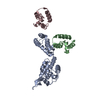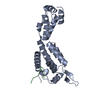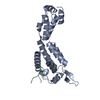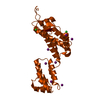[English] 日本語
 Yorodumi
Yorodumi- PDB-8cky: HIV-1 mature capsid hexamer from CA-IP6 CLPs, bound to Nup153 peptide -
+ Open data
Open data
- Basic information
Basic information
| Entry | Database: PDB / ID: 8cky | ||||||||||||||||||
|---|---|---|---|---|---|---|---|---|---|---|---|---|---|---|---|---|---|---|---|
| Title | HIV-1 mature capsid hexamer from CA-IP6 CLPs, bound to Nup153 peptide | ||||||||||||||||||
 Components Components |
| ||||||||||||||||||
 Keywords Keywords |  VIRUS LIKE PARTICLE / VIRUS LIKE PARTICLE /  Capsid / Capsid /  Hexamer / Hexamer /  HIV-1 / Mature / HIV-1 / Mature /  Nup153 Nup153 | ||||||||||||||||||
| Function / homology |  Function and homology information Function and homology informationnegative regulation of RNA export from nucleus /  nuclear pore complex assembly / Nuclear Pore Complex (NPC) Disassembly / nuclear inclusion body / nuclear pore nuclear basket / Transport of Ribonucleoproteins into the Host Nucleus / Regulation of Glucokinase by Glucokinase Regulatory Protein / Defective TPR may confer susceptibility towards thyroid papillary carcinoma (TPC) / Transport of the SLBP independent Mature mRNA / Transport of the SLBP Dependant Mature mRNA ...negative regulation of RNA export from nucleus / nuclear pore complex assembly / Nuclear Pore Complex (NPC) Disassembly / nuclear inclusion body / nuclear pore nuclear basket / Transport of Ribonucleoproteins into the Host Nucleus / Regulation of Glucokinase by Glucokinase Regulatory Protein / Defective TPR may confer susceptibility towards thyroid papillary carcinoma (TPC) / Transport of the SLBP independent Mature mRNA / Transport of the SLBP Dependant Mature mRNA ...negative regulation of RNA export from nucleus /  nuclear pore complex assembly / Nuclear Pore Complex (NPC) Disassembly / nuclear inclusion body / nuclear pore nuclear basket / Transport of Ribonucleoproteins into the Host Nucleus / Regulation of Glucokinase by Glucokinase Regulatory Protein / Defective TPR may confer susceptibility towards thyroid papillary carcinoma (TPC) / Transport of the SLBP independent Mature mRNA / Transport of the SLBP Dependant Mature mRNA / NS1 Mediated Effects on Host Pathways / SUMOylation of SUMOylation proteins / Transport of Mature mRNA Derived from an Intronless Transcript / structural constituent of nuclear pore / Rev-mediated nuclear export of HIV RNA / nuclear pore complex assembly / Nuclear Pore Complex (NPC) Disassembly / nuclear inclusion body / nuclear pore nuclear basket / Transport of Ribonucleoproteins into the Host Nucleus / Regulation of Glucokinase by Glucokinase Regulatory Protein / Defective TPR may confer susceptibility towards thyroid papillary carcinoma (TPC) / Transport of the SLBP independent Mature mRNA / Transport of the SLBP Dependant Mature mRNA / NS1 Mediated Effects on Host Pathways / SUMOylation of SUMOylation proteins / Transport of Mature mRNA Derived from an Intronless Transcript / structural constituent of nuclear pore / Rev-mediated nuclear export of HIV RNA /  host cell / SUMOylation of RNA binding proteins / Nuclear import of Rev protein / RNA export from nucleus / Transport of Mature mRNA derived from an Intron-Containing Transcript / NEP/NS2 Interacts with the Cellular Export Machinery / tRNA processing in the nucleus / nucleocytoplasmic transport / Viral Messenger RNA Synthesis / host cell / SUMOylation of RNA binding proteins / Nuclear import of Rev protein / RNA export from nucleus / Transport of Mature mRNA derived from an Intron-Containing Transcript / NEP/NS2 Interacts with the Cellular Export Machinery / tRNA processing in the nucleus / nucleocytoplasmic transport / Viral Messenger RNA Synthesis /  nuclear localization sequence binding / SUMOylation of ubiquitinylation proteins / Vpr-mediated nuclear import of PICs / SUMOylation of DNA replication proteins / Regulation of HSF1-mediated heat shock response / mRNA transport / SUMOylation of DNA damage response and repair proteins / nuclear localization sequence binding / SUMOylation of ubiquitinylation proteins / Vpr-mediated nuclear import of PICs / SUMOylation of DNA replication proteins / Regulation of HSF1-mediated heat shock response / mRNA transport / SUMOylation of DNA damage response and repair proteins /  nuclear pore / protein-membrane adaptor activity / viral process / SUMOylation of chromatin organization proteins / nuclear periphery / HCMV Late Events / Transcriptional regulation by small RNAs / ISG15 antiviral mechanism / HCMV Early Events / protein import into nucleus / viral penetration into host nucleus / nuclear pore / protein-membrane adaptor activity / viral process / SUMOylation of chromatin organization proteins / nuclear periphery / HCMV Late Events / Transcriptional regulation by small RNAs / ISG15 antiviral mechanism / HCMV Early Events / protein import into nucleus / viral penetration into host nucleus /  nuclear envelope / nuclear envelope /  snRNP Assembly / viral nucleocapsid / snRNP Assembly / viral nucleocapsid /  nuclear membrane / host cell cytoplasm / symbiont entry into host cell / nuclear membrane / host cell cytoplasm / symbiont entry into host cell /  nucleolus / SARS-CoV-2 activates/modulates innate and adaptive immune responses / virion membrane / structural molecule activity / nucleolus / SARS-CoV-2 activates/modulates innate and adaptive immune responses / virion membrane / structural molecule activity /  DNA binding / DNA binding /  RNA binding / zinc ion binding / RNA binding / zinc ion binding /  nucleoplasm / nucleoplasm /  membrane / identical protein binding / membrane / identical protein binding /  metal ion binding / metal ion binding /  cytosol / cytosol /  cytoplasm cytoplasmSimilarity search - Function | ||||||||||||||||||
| Biological species |    Human immunodeficiency virus 1 Human immunodeficiency virus 1  Homo sapiens (human) Homo sapiens (human) | ||||||||||||||||||
| Method |  ELECTRON MICROSCOPY / ELECTRON MICROSCOPY /  single particle reconstruction / single particle reconstruction /  cryo EM / Resolution: 2.6 Å cryo EM / Resolution: 2.6 Å | ||||||||||||||||||
 Authors Authors | Stacey, J.C.V. / Briggs, J.A.G. | ||||||||||||||||||
| Funding support |  Germany, Germany,  United States, United States,  United Kingdom, 5items United Kingdom, 5items
| ||||||||||||||||||
 Citation Citation |  Journal: Proc Natl Acad Sci U S A / Year: 2023 Journal: Proc Natl Acad Sci U S A / Year: 2023Title: Two structural switches in HIV-1 capsid regulate capsid curvature and host factor binding. Authors: James C V Stacey / Aaron Tan / John M Lu / Leo C James / Robert A Dick / John A G Briggs /    Abstract: The mature HIV-1 capsid protects the viral genome and interacts with host proteins to travel from the cell periphery into the nucleus. To achieve this, the capsid protein, CA, constructs conical ...The mature HIV-1 capsid protects the viral genome and interacts with host proteins to travel from the cell periphery into the nucleus. To achieve this, the capsid protein, CA, constructs conical capsids from a lattice of hexamers and pentamers, and engages in and then relinquishes multiple interactions with cellular proteins in an orchestrated fashion. Cellular host factors including Nup153, CPSF6, and Sec24C engage the same pocket within CA hexamers. How CA assembles pentamers and hexamers of different curvatures, how CA oligomerization states or curvature might modulate host-protein interactions, and how binding of multiple cofactors to a single site is coordinated, all remain to be elucidated. Here, using single-particle cryoEM, we have determined the structure of the mature HIV-1 CA pentamer and hexamer from conical CA-IP polyhedra to ~3 Å resolution. We also determined structures of hexamers in the context of multiple lattice curvatures and number of pentamer contacts. Comparison of these structures, bound or not to host protein peptides, revealed two structural switches within HIV-1 CA that modulate peptide binding according to CA lattice curvature and whether CA is hexameric or pentameric. These observations suggest that the conical HIV-1 capsid has different host-protein binding properties at different positions on its surface, which may facilitate cell entry and represent an evolutionary advantage of conical morphology. | ||||||||||||||||||
| History |
|
- Structure visualization
Structure visualization
| Structure viewer | Molecule:  Molmil Molmil Jmol/JSmol Jmol/JSmol |
|---|
- Downloads & links
Downloads & links
- Download
Download
| PDBx/mmCIF format |  8cky.cif.gz 8cky.cif.gz | 49 KB | Display |  PDBx/mmCIF format PDBx/mmCIF format |
|---|---|---|---|---|
| PDB format |  pdb8cky.ent.gz pdb8cky.ent.gz | 34.1 KB | Display |  PDB format PDB format |
| PDBx/mmJSON format |  8cky.json.gz 8cky.json.gz | Tree view |  PDBx/mmJSON format PDBx/mmJSON format | |
| Others |  Other downloads Other downloads |
-Validation report
| Arichive directory |  https://data.pdbj.org/pub/pdb/validation_reports/ck/8cky https://data.pdbj.org/pub/pdb/validation_reports/ck/8cky ftp://data.pdbj.org/pub/pdb/validation_reports/ck/8cky ftp://data.pdbj.org/pub/pdb/validation_reports/ck/8cky | HTTPS FTP |
|---|
-Related structure data
| Related structure data |  16706MC  8ckvC  8ckwC  8ckxC  8ckzC  8cl0C  8cl1C  8cl2C  8cl3C  8cl4C M: map data used to model this data C: citing same article ( |
|---|---|
| Similar structure data | Similarity search - Function & homology  F&H Search F&H Search |
- Links
Links
- Assembly
Assembly
| Deposited unit | 
|
|---|---|
| 1 | x 6
|
- Components
Components
| #1: Protein |  Group-specific antigen Group-specific antigenMass: 25761.623 Da / Num. of mol.: 1 Source method: isolated from a genetically manipulated source Source: (gene. exp.)    Human immunodeficiency virus 1 / Gene: gag / Production host: Human immunodeficiency virus 1 / Gene: gag / Production host:   Escherichia coli BL21 (bacteria) / References: UniProt: B6DRA0 Escherichia coli BL21 (bacteria) / References: UniProt: B6DRA0 |
|---|---|
| #2: Protein/peptide |  Nuclear pore / 153 kDa nucleoporin / Nucleoporin Nup153 Nuclear pore / 153 kDa nucleoporin / Nucleoporin Nup153Mass: 1687.721 Da / Num. of mol.: 1 / Fragment: UNP residues 1407-1423 / Source method: obtained synthetically / Source: (synth.)   Homo sapiens (human) / References: UniProt: P49790 Homo sapiens (human) / References: UniProt: P49790 |
-Experimental details
-Experiment
| Experiment | Method:  ELECTRON MICROSCOPY ELECTRON MICROSCOPY |
|---|---|
| EM experiment | Aggregation state: PARTICLE / 3D reconstruction method:  single particle reconstruction single particle reconstruction |
- Sample preparation
Sample preparation
| Component | Name: HIV-1 Mature Capsid / Type: COMPLEX Details: Hexamer bound to FG repeat containing Nup153 peptide. Entity ID: all / Source: RECOMBINANT | ||||||||||||||||||||||||||||||
|---|---|---|---|---|---|---|---|---|---|---|---|---|---|---|---|---|---|---|---|---|---|---|---|---|---|---|---|---|---|---|---|
| Molecular weight | Value: 0.027 MDa / Experimental value: NO | ||||||||||||||||||||||||||||||
| Source (natural) | Organism:    Human immunodeficiency virus 1 Human immunodeficiency virus 1 | ||||||||||||||||||||||||||||||
| Source (recombinant) | Organism:   Escherichia coli (E. coli) Escherichia coli (E. coli) | ||||||||||||||||||||||||||||||
| Buffer solution | pH: 6.1 | ||||||||||||||||||||||||||||||
| Buffer component |
| ||||||||||||||||||||||||||||||
| Specimen | Conc.: 0.5 mg/ml / Embedding applied: NO / Shadowing applied: NO / Staining applied : NO / Vitrification applied : NO / Vitrification applied : YES / Details: VLP assembly, bound to Nup153 peptide. : YES / Details: VLP assembly, bound to Nup153 peptide. | ||||||||||||||||||||||||||||||
| Specimen support | Grid material: COPPER / Grid mesh size: 200 divisions/in. / Grid type: C-flat-2/2 | ||||||||||||||||||||||||||||||
Vitrification | Instrument: FEI VITROBOT MARK IV / Cryogen name: ETHANE / Humidity: 100 % / Chamber temperature: 291 K |
- Electron microscopy imaging
Electron microscopy imaging
| Experimental equipment |  Model: Titan Krios / Image courtesy: FEI Company |
|---|---|
| Microscopy | Model: FEI TITAN KRIOS |
| Electron gun | Electron source : :  FIELD EMISSION GUN / Accelerating voltage: 300 kV / Illumination mode: FLOOD BEAM FIELD EMISSION GUN / Accelerating voltage: 300 kV / Illumination mode: FLOOD BEAM |
| Electron lens | Mode: BRIGHT FIELD Bright-field microscopy / Nominal magnification: 130000 X / Nominal defocus max: 3000 nm / Nominal defocus min: 600 nm / Cs Bright-field microscopy / Nominal magnification: 130000 X / Nominal defocus max: 3000 nm / Nominal defocus min: 600 nm / Cs : 2.7 mm / C2 aperture diameter: 50 µm / Alignment procedure: ZEMLIN TABLEAU : 2.7 mm / C2 aperture diameter: 50 µm / Alignment procedure: ZEMLIN TABLEAU |
| Specimen holder | Cryogen: NITROGEN / Specimen holder model: FEI TITAN KRIOS AUTOGRID HOLDER |
| Image recording | Electron dose: 40 e/Å2 / Film or detector model: FEI FALCON IV (4k x 4k) / Num. of grids imaged: 1 / Num. of real images: 4770 |
| EM imaging optics | Energyfilter name : TFS Selectris / Energyfilter slit width: 20 eV : TFS Selectris / Energyfilter slit width: 20 eV |
| Image scans | Sampling size: 14 µm / Width: 4096 / Height: 4096 |
- Processing
Processing
| Software | Name: PHENIX / Version: dev_3689: / Classification: refinement | ||||||||||||||||||||||||||||||||||||||||||||||||
|---|---|---|---|---|---|---|---|---|---|---|---|---|---|---|---|---|---|---|---|---|---|---|---|---|---|---|---|---|---|---|---|---|---|---|---|---|---|---|---|---|---|---|---|---|---|---|---|---|---|
| EM software |
| ||||||||||||||||||||||||||||||||||||||||||||||||
CTF correction | Type: PHASE FLIPPING AND AMPLITUDE CORRECTION | ||||||||||||||||||||||||||||||||||||||||||||||||
| Particle selection | Num. of particles selected: 1457736 | ||||||||||||||||||||||||||||||||||||||||||||||||
| Symmetry | Point symmetry : C6 (6 fold cyclic : C6 (6 fold cyclic ) ) | ||||||||||||||||||||||||||||||||||||||||||||||||
3D reconstruction | Resolution: 2.6 Å / Resolution method: FSC 0.143 CUT-OFF / Num. of particles: 595899 / Algorithm: BACK PROJECTION / Num. of class averages: 4 / Symmetry type: POINT | ||||||||||||||||||||||||||||||||||||||||||||||||
| Atomic model building | Protocol: RIGID BODY FIT / Space: REAL / Target criteria: Cross-correlation | ||||||||||||||||||||||||||||||||||||||||||||||||
| Atomic model building |
| ||||||||||||||||||||||||||||||||||||||||||||||||
| Refine LS restraints |
|
 Movie
Movie Controller
Controller











 PDBj
PDBj




















